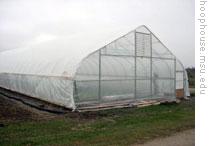2009-12-21
This is the VOA Special English Agriculture Report.
Today we discuss the greenhouse effect.
Farmers and gardeners have long used greenhouses to extend the growing season in cold weather. Now, hoop houses are gaining popularity. Hoop houses are sometimes called a temporary greenhouse or passive solar greenhouse.
 |
| Some hoop houses are rounded; others are shaped more like a traditional house |
Now, the United States Department of Agriculture has announced a program to help farmers who want to build hoop houses.
The department, through its Cooperative State Research, Education and Extension Service, has been supporting a project in Michigan. That state has a short growing season.
As part of the research project, nine farmers were given materials and trained how to build and use a hoop house. The results showed that well-managed hoop houses can grow high-quality crops.
However, crops are not the only things that grow well. The research found that weeds grow faster in a hoop house. Weeding, seeding and watering requires at least as much work as crops grown in the open air. The researchers also advise growers to add compost material to the soil in hoop houses to build nutrients.
Eliot Coleman is an organic farmer and a writer in Maine who has helped popularize the idea of four-season farming. His ideas about hoop houses sounded good to John Biernbaum in the Horticulture Department at Michigan State University.
Professor Biernbaum tried hoop houses on the Student Organic Farm at Michigan State and had success. Project director David Conner says it was a "test drive" for the research on private farms. The agricultural economist points to the demand for locally grown crops. "People are hungry for good, fresh vegetables," he says.
Hoop houses for winter growing can even be found at the White House, where Michelle Obama has a vegetable garden. The houses are small because of limited space on the South Lawn.
A hoop house specialist at Michigan State University, Adam Montri, has videos on YouTube explaining how to build one. You can go to 51voa.com and find a link to his videos and also a link to our videos on YouTube.
And that's the VOA Special English Agriculture Report, written by Jerilyn Watson. I'm Bob Doughty.